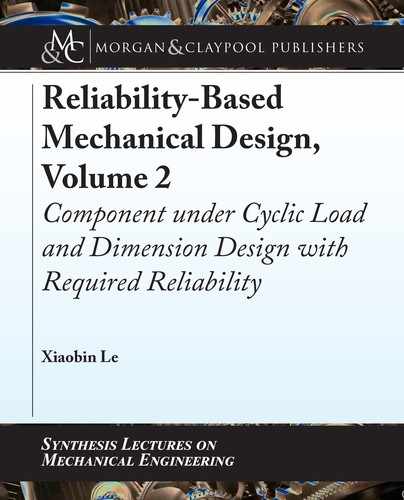
2.7. RELIABILITY OF A COMPONENT WITH AN INFINITE LIFE 27
ˇ D 2:72094 R D ˆ
.
2:72094
/
D 0:9968:
Table 2.6: e iterative results of Example 2.6 by the H-L method
Iterative #
M
*
k
a
*
S
'
*
e
k
f
*
d
*
β
*
|∆β
*
|
1 1.384144 0.905 24.7 1.562 1.050139 2.993
2 1.800485 0.85477 21.84149 1.716223 1.256083 2.72047 0.272531
3 1.808252 0.85755 21.81578 1.687236 1.249902 2.720937 0.000468
4 1.807202 0.857805 21.81853 1.689117 1.249948 2.72094 2.67E-06
Example 2.8
e critical section of a constant rectangular cross-section beam with a height h D 2:00 ˙ 0:010
00
and a width b D 2:0 ˙ 0:010
00
is under a cyclic bending loading. is cyclic bending loading
has a constant mean bending moment M
m
D 20:5 (klb.in). Its bending moment amplitude can
be treated as a normal distribution with a mean
M
a
D 11:5 (klb.in) and a standard deviation
M
a
D 1:5 (klb.in). e beam can be treated as a hot-rolled component. e beam material’s
ultimate strength is 61.5 (ksi). Its endurance limit S
0
e
follows a normal distribution with a mean
S
0
e
D 24:7 (ksi) and a standard deviation
S
0
e
D 2:14 (ksi), which are based on fatigue tests
under fully reversed bending loading. is beam is designed to have an infinite life. (1) Establish
the limit state function of this beam at the critical cross-section. (2) Calculate the reliability of
the beam by using the Monte Carlo method, the relative error and the reliability range with a
95% confidence level.
Solution:
(1) Establish the limit state function of this beam at the critical cross-section.
We can use Equation (2.26) to establish the limit state function for this problem.
Per Equation (2.12), the component endurance limit will be:
S
e
D k
a
k
b
k
c
S
0
e
: (a)
e mean and standard deviations of the surface finish modification factor k
a
of the hot-rolled
component can be calculated per Equations (2.14), (2.15), and (2.16):
k
a
D 0:772I
k
a
D 0:0757: (b)
Per Equation (2.17), the size modification factor k
b
will be treated as a constant. Since the
cross-section is not a circular cross-section and the beam is not a rotating component, the equiv-
alent diameter should be used for the calculation. e equivalent diameter [2] for non-rotating

28 2. RELIABILITY OF A COMPONENT UNDER CYCLIC LOAD
rectangular cross-section for this case is d
e
D 0:808
p
bh D 0:808
p
2 2 D 1:616
00
. So, the size
modification factor k
b
can be calculated per Equation (2.17):
k
b
D
d
0:3
0:1133
D
1:616
0:3
0:1133
D 0:826: (c)
Per Equations (2.18), (2.19), and (2.20), the loading modification factor k
c
will be treated as a
constant 1 due to the cyclic bending stress:
k
c
D 1: (d)
For this problem, the fatigue stress concentration factor K
f
will be equal to 1 due to a constant
cross-section.
e mean stress
m
and the stress amplitude
a
on the critical cross-section due to the
cyclic bending moment can be calculated by the following equations:
m
D
M
m
h
2
bh
3
=12
D
6F
m
bh
3
D
6 20:5
bh
2
D
123
bh
2
.ksi/ (e)
a
D
M
a
h
2
bh
3
=12
D
6M
a
bh
2
.ksi/: (f)
e height h and the width b of the beam can be treated as normally distributed random vari-
ables. eir means and standard deviations can be determined per Equation (1.1):
h
D 2:0;
h
D
0:010 .0:010/
8
D 0:0025 (g)
b
D 1:0;
b
D
0:010 .0:010/
8
D 0:0025: (h)
Since the cyclic bending stress is not a fully reversed cyclic stress, we need to use Equation (2.21)
to consider the effect of mean stress and to convert it into a fully reversed cyclic stress with an
equivalent stress amplitude:
aeq
D
a
S
ut
S
ut
m
D
6M
a
bh
2
0
B
@
61:5
61:5
123
bh
2
1
C
A
D
369M
a
61:5bh
2
123
: (i)
Now, by using all information from (a)–(i), we can establish the limit state function for this
problem per Equation (2.26):
g
k
a
; S
0
e
; h; b; M
a
D 0:826k
a
S
0
e
369M
a
61:5bh
2
123
: (j)
In this example, all random variables in the limit state function (j) are normal distributions. eir
distribution parameters are listed in Table 2.7.
..................Content has been hidden....................
You can't read the all page of ebook, please click here login for view all page.
